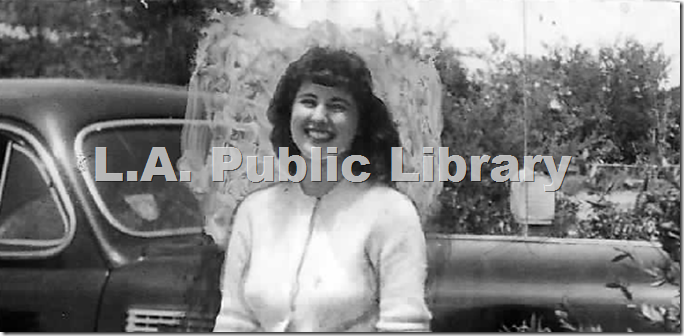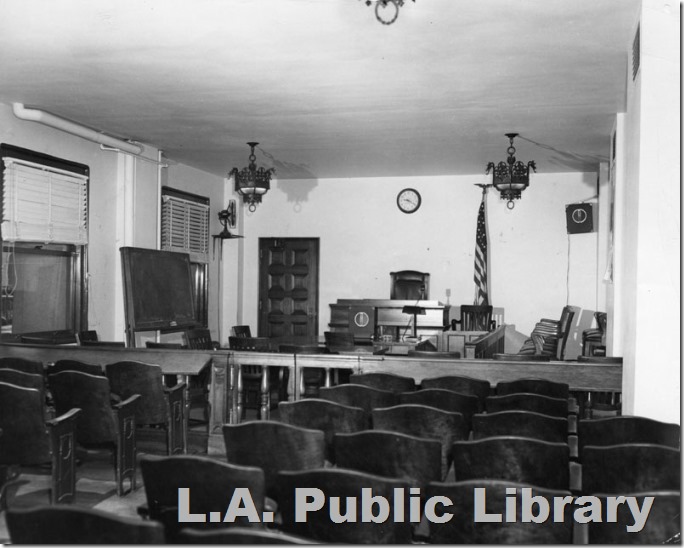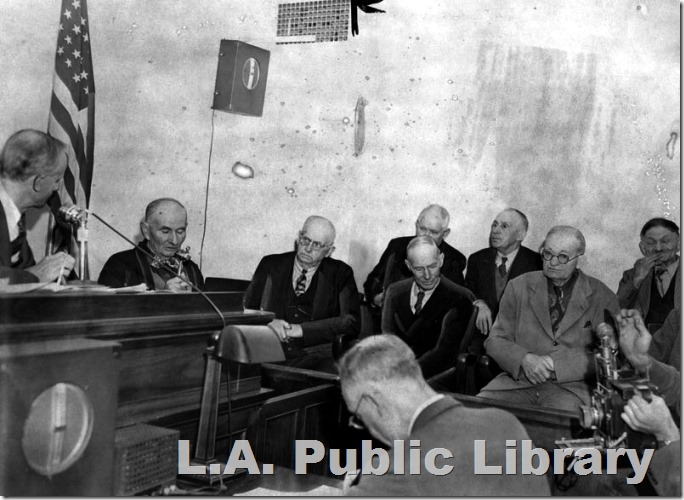
Georgette Bauerdorf in an undated photo, courtesy of the Los Angeles Public Library.
The life of a diligent researcher would be much easier if one of the Los Angeles newspapers had published details from the coroner’s inquest in the Georgette Bauerdorf case, particularly the transcript of the autopsy.
Georgette Bauerdorf, an Unsolved Murder:
Part 1 | Part 2 | Part 3 | Part 4 | Part 5 | Part 6 | Part 7 | Part 8 | Part 9 | Part 10 | Part 11 | Part 12 | Part 13 | Part 14 | Part 15 | Part 16 | Part 17 | Part 18 | Part 19 | Part 20 | Part 21 | Part 22 | Part 23 | Part 24 | Part 25 | Part 26 | Part 27 | Part 28 | Part 29 | Part 30 | Part 31

The Los Angeles County coroner’s jury room, courtesy of the Los Angeles Public Library.
The inquests of the 1940s were conducted as a trial and held in the coroner’s area of the Hall of Justice, with a small jury and deputy corner presiding instead of a judge.
A witness identified the victim, another witness might describe the victim’s death or finding the body, detectives described the crime scene and the medical examiner either read his report into the official record or in some instances it was introduced into the record in the medical examiner’s absence.
After hearing the testimony, the coroner’s jury returned with a finding of death at the hands of another, natural death, etc. In the Bauerdorf inquest, the witnesses were attorney Sam Wolf, who identified the victim; Fred/Charles Atwood, who found the body; and two investigators (Daily News, Oct. 20, 1944).

A typical inquest of the 1940s: Edward Merrifield testifies in a fatal 1947 traffic accident in which 7-year-old Patrick Burns was run down in a crosswalk, courtesy of the Los Angeles Public Library. At right is the coroner’s jury and at left is the coroner’s official presiding over the inquest.
The Oct. 20, 1944, Bauerdorf inquest received sketchy coverage by the Los Angeles papers, so the diligent researcher must rely on what can be gleaned from news reports.
The body of Georgette Bauerdorf was found between 11 a.m. and 11:30 a.m. on Thursday, Oct. 12, 1944, in the second-floor bathroom of her apartment at El Palacio, 8493 Fountain Ave. According to Fred Atwood, janitor at El Palacio, she was wearing the top half of a pair of pink rayon pajamas and floating face-down the bathtub, which was overflowing with bloody, hot water because the faucet was either running or dripping. Atwood said that the bathroom was stifling hot.
 Fred Atwood, left, describes finding the body and Sam Wolf identifies the victim, Los Angeles Times, Oct. 21, 1944
Fred Atwood, left, describes finding the body and Sam Wolf identifies the victim, Los Angeles Times, Oct. 21, 1944
Atwood said that rigor mortis had set in when he found her. Sheriff’s Inspector William Penprase said that rigor mortis usually sets in within three to four hours after death, but that it would have been delayed because the body was in a tub of hot water.
During the initial investigation, Georgette’s father, George Bauerdorf, said she might have died of natural causes. “We know that she suffered from cramps and heart pains and we think they might have caused death,” he said. (Los Angeles Herald-Express, Oct. 13, 1944).
Judging by news accounts, autopsy surgeon Frank R. Webb made an initial examination that determined a cause of death and a second, more thorough examination, which provided details on the injuries inflicted by the killer. Some tests were delayed because of the Columbus Day holiday, according to news stories.
The cause of death was established as strangulation with a piece of fabric (more about this later) that had been jammed about 4 inches down the victim’s throat. Apparently her jaws were clenched and her mouth was closed so that the fabric was not initially visible, leading to speculation that she had drowned in the tub, although only a few drops of water were found in her lungs.
There apparently had been a corner of the fabric protruding from her mouth. Someone (possibly the killer) apparently tried to remove the fabric but the corner ripped away because her jaws were clenched due to rigor mortis. This corner piece was never found, according to the original news accounts.
There was speculation in the original news accounts that the killer used this piece of fabric when attempting to clean up blood on the bedroom rug, but this was never confirmed.
News accounts indicate that Webb performed an initial examination on Georgette on Friday, Oct. 13, 1944. Dispelling the notion that Georgette might have drowned, Webb said “the girl had a forced sexual relation shortly before her death by strangulation.” (Daily News, Oct. 14, 1944).
The Times reported (Oct. 13, 1944) that she had a bloody nose. “There was a large contusion on the right side of her head, as could be caused by a fist blow, and another on her abdomen.” (The Times, Oct. 15, 1955)
Webb said “abrasions on the knuckles of the girl’s hands showed she had fought desperately against the attacker.” (Examiner, Oct. 15, 1944)
Webb also said: “Thumb and finger marks on her face, lips abdomen and thighs prove the attacker was powerful with almost ape-like hands.” (Examiner, Oct. 15, 1944).

The fabric recovered from Georgette Bauerdorf, courtesy of the Los Angeles Public Library.
“On her right thigh, Dr. Webb said, was the bruised imprint of a hand even to the fingernail marks piercing the skin.” (The Times, Oct. 15, 1944).
As for the contents of her stomach, there are discrepancies in the news accounts between what was found in the autopsy and evidence recovered in her kitchen.
The Daily News (Oct. 14, 1944) said, based on preliminary results from the autopsy: “All that is known is that she stopped somewhere on the way home and ate a substantial dinner, including meat and string beans, about an hour and a half before she died.”
The Times said (Oct. 14, 1944): The autopsy showed that the girl had eaten a sizable dinner before going home (there was no evidence of food preparation at the apartment). “Her lips were bruised and her mouth torn from the size of the gag,” The Times said.
The Times (Oct. 21, 1944) reported: “[Sheriff’s Lt. Ray T.] Hopkinson said that in the kitchen he found a single knife and fork, along with evidence showing she had consumed a can of beans and a half of cantaloupe — alone — before she was slain.”
It’s fairly certain that string beans were found in her stomach and that an empty can that had contained string beans was found in the kitchen wastebasket. Melon rinds were found in the wastebasket, but no news account ever states whether melon was found in her stomach. The Daily News says meat was found in her stomach, but there is no indication that meat was prepared in the kitchen. But in any event, she had apparently eaten a substantial meal.
No news reports mention whether the autopsy detected alcohol.
To be continued.


Aside from the fact that you are repeating things several times in each segment of this blog (i.e. string beans, melon, etc),,,,
The reported rigor mortis was reported to take several hours before setting
into the corpse. As such, your writing here makes it appear that the killer remained with the corpse during those several hours. Otherwise, how would her teeth be clenched and the killer unable to remove the oral gag / tearing a piece off? That doesn’t make sense.
What stands out as very suspicious is the fact that the father would testify that he felt she may have died a natural death due to “heart pains” etc. Based upon just the scant details of this blog, if I were a cop, I’d be looking closely at the father for that reason. He would appear to be trying to refute the homicide.
LikeLike
Jason, George Bauerdorf was on the East Coast with Georgette’s sister and stepmother. That’s why Georgette was living in the apartment by herself.
LikeLike
It still doesn’t preclude murder for hire. I can’t imagine someone wealthy dirtying their own hands. Although this would open up the possibility of blackmail.
That being said, so far I don’t believe her family had anything to do with her death. I can’t think of a motive, mainly because her sister was never harmed. And it would take the horrible treatment of her body to an entire other disturbing level.
LikeLike
Was there any evidence that she might have had a late night visit from a fellow resident…to chat about her day?
LikeLike
No, nothing.
LikeLike
Quite possible the killer stayed in the apartment for a significant amount of time after murdering her and the reason certain foods from her kitchen weren’t found in her stomach during the autopsy was because he ate them.
There is plenty of precedent in other homicide cases for this type of behavior from a murderer and could offer some type of insight into a potential offender profile.
LikeLike
After reading this, that was my thought too.
LikeLike
Since there was no apparent forced entry, she would appear to have been acquainted with her killer.
Her muffled scream “you’re killing me” also was late… indicating that perhaps she had been with the person for some period of time before he killed her as she otherwise would have been screaming her head off the moment she encountered a stranger inside the apartment.
Its all speculation, though, and unfortunate that DNA testing was not in existence back then. I suspect that her killer probably went on to rape / kill other women in his lifetime.
Whats not speculation is that when a female thinks its okay to allow total strangers sleep inside their home… thats a really dangerous thing to do. Smiling strangers are just as dangerous as someone who appears dangerous. Look at serial killer Ted Bundy… he overcame female concerns with his smile.
LikeLike
Poor girl, what an awful way to die.
She WAS careless, meeting strange men, and letting military fellows bunk down in her apt.–but it was a different time. My mother worked for the Navy in Miami during WWII, and said people were thrown together in a way that would look Highly Suspicious just five years later (still, Mom had a roomie and would never have let a strange man spend the night . . . well, not unless he looked like Tyrone Power, she wasn’t made of stone).
LikeLike
This thing about the string beans nettles me. She had meat and string beans in her stomach, but didn’t cook the meat at home. However, an empty can of string beans was found in her home. So either the killer ate the canned beans, and Georgette’s beans were from a restaurant, or Georgette ate the beans at home after she had had only meat at a restaurant? That seems really strange. Could she have picked up a piece of cooked meat at a deli or someplace like that, to take home, and made a regular meal at home by adding the beans? (I’m also curious to know what constituted a “substantial” dinner at that time–I suspect it would have been a smaller amount than today. And why does more than one paper bother to mention that the meal was “substantial,” “sizable”–it’s like they’re trying to shame her for eating too much.)
LikeLike
All good questions….
LikeLike
Pingback: Georgette Bauerdorf, an Unsolved Murder, Part 30 |
Pingback: Georgette Bauerdorf, an Unsolved Murder, Part 29 |
Pingback: Georgette Bauerdorf, an Unsolved Murder, Part 28 |
Pingback: Georgette Bauerdorf, an Unsolved Murder, Part 27 |
Pingback: Georgette Bauerdorf, an Unsolved Murder, Part 26 |
Pingback: Georgette Bauerdorf, an Unsolved Murder, Part 25 |
Pingback: Georgette Bauerdorf, an Unsolved Murder, Part 23 |
Pingback: Georgette Bauerdorf, an Unsolved Murder, Part 17 |